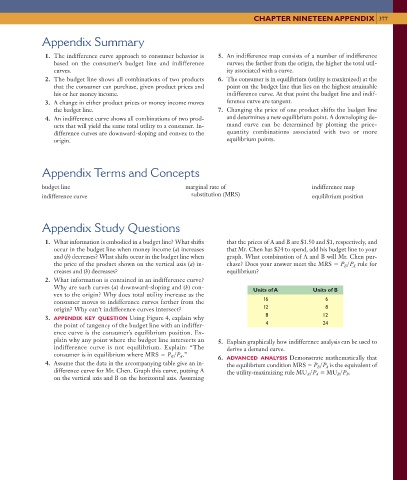Page 445 - Economics
P. 445
CONFIRMING PAGES
CHAPTER NINETEEN APPENDIX 377
Appendix Summary
1. The indifference curve approach to consumer behavior is 5. An indifference map consists of a number of indifference
based on the consumer’s budget line and indifference curves; the farther from the origin, the higher the total util-
curves. ity associated with a curve.
2. The budget line shows all combinations of two products 6. The consumer is in equilibrium (utility is maximized) at the
that the consumer can purchase, given product prices and point on the budget line that lies on the highest attainable
his or her money income. indifference curve. At that point the budget line and indif-
3. A change in either product prices or money income moves ference curve are tangent.
the budget line. 7. Changing the price of one product shifts the budget line
4. An indifference curve shows all combinations of two prod- and determines a new equilibrium point. A downsloping de-
ucts that will yield the same total utility to a consumer. In- mand curve can be determined by plotting the price-
difference curves are downward-sloping and convex to the quantity combinations associated with two or more
origin. equilibrium points.
Appendix Terms and Concepts
budget line marginal rate of indifference map
indifference curve substitution (MRS) equilibrium position
Appendix Study Questions
1. What information is embodied in a budget line? What shifts that the prices of A and B are $1.50 and $1, respectively, and
occur in the budget line when money income ( a ) increases that Mr. Chen has $24 to spend, add his budget line to your
and ( b ) decreases? What shifts occur in the budget line when graph. What combination of A and B will Mr. Chen pur-
the price of the product shown on the vertical axis ( a ) in- chase? Does your answer meet the MRS P B P A rule for
creases and ( b ) decreases? equilibrium?
2. What information is contained in an indifference curve?
Why are such curves ( a ) downward-sloping and ( b ) con-
Units of A Units of B
vex to the origin? Why does total utility increase as the
consumer moves to indifference curves farther from the 16 6
origin? Why can’t indifference curves intersect? 12 8
8 12
3. APPENDIX KEY QUESTION Using Figure 4 , explain why
the point of tangency of the budget line with an indiffer- 4 24
ence curve is the consumer’s equilibrium position. Ex-
plain why any point where the budget line intersects an 5. Explain graphically how indifference analysis can be used to
indifference curve is not equilibrium. Explain: “The derive a demand curve.
consumer is in equilibrium where MRS P B P A .”
6. ADVANCED ANALYSIS Demonstrate mathematically that
4. Assume that the data in the accompanying table give an in- the equilibrium condition MRS P B P A is the equivalent of
difference curve for Mr. Chen. Graph this curve, putting A the utility-maximizing rule MU A P A MU B P B .
on the vertical axis and B on the horizontal axis. Assuming
6/3/06 12:53:26 PM
mcc26632_ch19_359-377.indd 377 6/3/06 12:53:26 PM
mcc26632_ch19_359-377.indd 377

